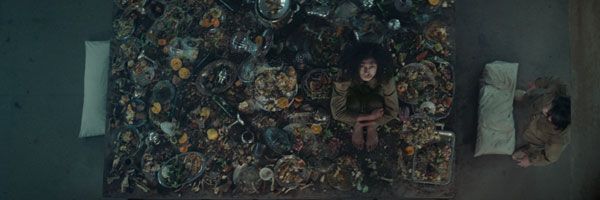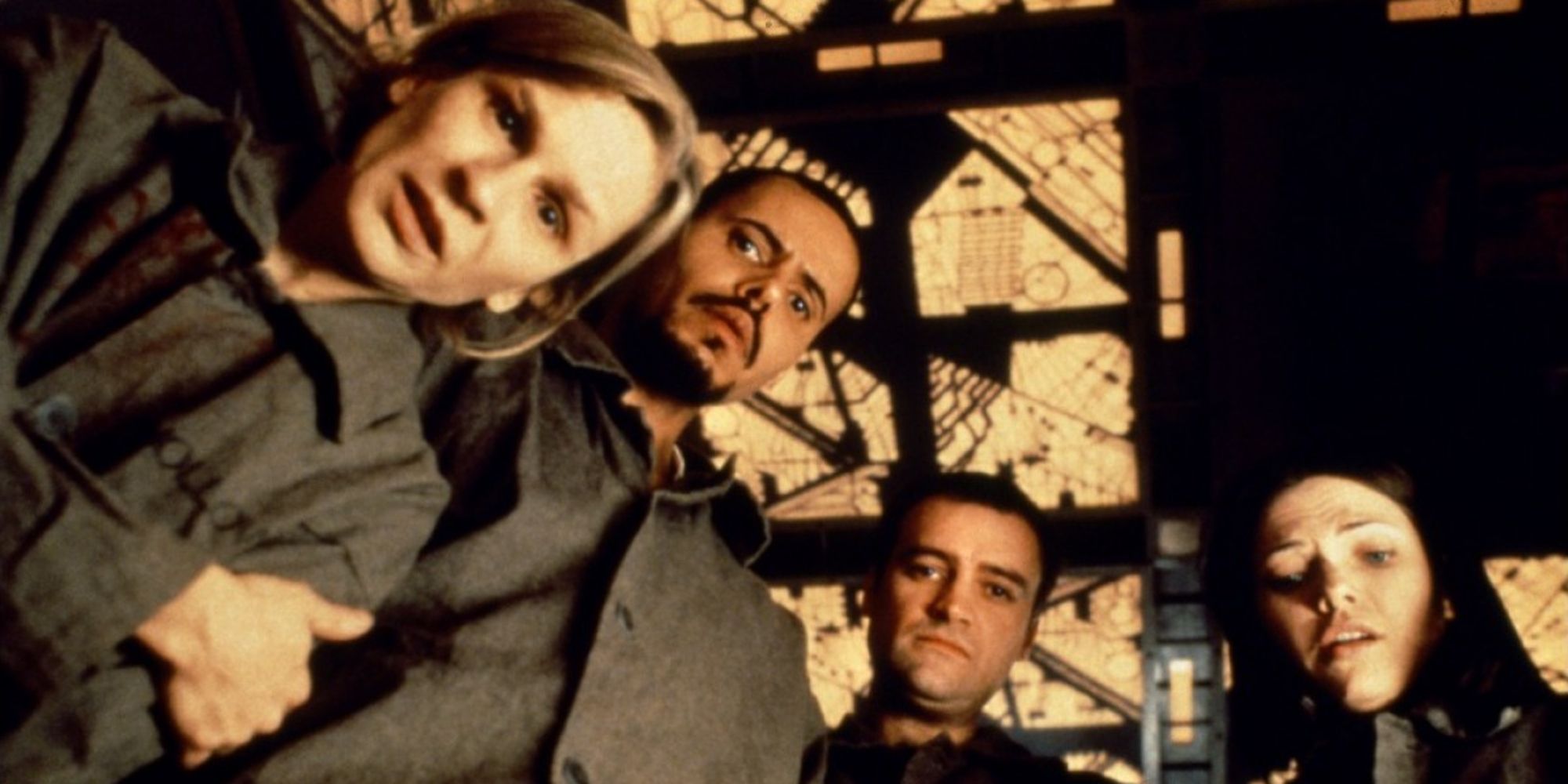The Big Picture
-
Cube
‘s understated brilliance paved the way for a sub-genre of horror films exploring human nature through escape room scenarios. - The film’s mathematical entanglement and social experiment elements set it apart from its more popular and gory successors like
Saw
and
Escape Room. - Ultimately,
Cube
‘s power lies in its ambiguity, leaving audiences in a state of uncertainty and reflection long after the credits roll.
As far as revolutionary horror movies go, Cube (1997) is far more underrated than it deserves to be, especially considering the fact it incited the creation of a widely popular sub-genre of horror. Director Vincenzo Natali‘s debut film contained the precursors of the escape room genre while mixing in elements of social experiment horror. The puzzle-solving and entrapment side inspired the notorious Saw (2004) and, later on, a series of 2000s escape room films like the more recent Escape Room (2019). On the other hand, the claustrophobia and meditation on human nature appear in later social experiment movies like Circle (2015) and The Platform (2019). With a small budget of $350,000 and a largely unheard of cast, Cube fit snugly in this found-footage-adjacent horror sub-genre that liberally used realism and voyeurism to explore the human condition.
Despite its influence, decades later, Cube has been lost to time. Perhaps its overbearing sequel and prequel, created by different filmmakers, overshadowed the quality of the first. These subsequent films mangle one of the strongest qualities of the original move – its ambiguity. Following a group of strangers stuck in a cube with doors on each of the six sides that lead to more cubes inside a cuboid outer shell, Cube is as geometric and mathematical as it gets. While escaping, the group tries to find purpose and answers in this trap-laden cuboid labyrinth, but in the end, we and the sole escapee are engulfed by the blinding light of ignorance and uncertainty. While Cube leaves us wondering if the perpetrator is the government, mega-corporations, a random group of wealthy people or aliens, Hypercube (2002) and Cube Zero (2004) fill in the blanks for us, stripping the power out of the original film.
Cube (1997)
A group of strangers awaken to find themselves placed in a giant cube. Each one of them is gifted with a special skill and they must work together to escape an endless maze of deadly traps.
- Release Date
- September 9, 1997
- Director
- Vincenzo Natali
- Cast
- Nicole de Boer , Nicky Guadagni , David Hewlett , Andrew Miller , Julian Richings , Wayne Robson , Maurice Dean Wint
- Runtime
- 1h 30m
- Writers
- Vincenzo Natali , André Bijelic , Graeme Manson
- Production Company
- Cube Libre
‘Cube’ Pioneered the Escape Room Horror Sub-Genre
At first glance, Cube is a fairly understated watch – there is no indication that it would spurn a sub-genre that includes critically acclaimed films and franchises that have earned billions of dollars. While the puzzles are nowhere as near grandiose as those in Escape Room or gory as those in the Saw franchise, it has its own unique charm. At first, it seemed like the only feasible way through the luminous cubes was to test for traps by throwing in boots. Eventually, the resident mathematics student, Leaven (Nicole de Boer), discovers three numbers on each of the entrances and constantly deciphers, then re-evaluates the cipher throughout the film. First, a prime number means a trapped room; second, they indicate the cube’s co-ordinates on a three-dimensional plane; and third, they represent the movement of the mechanical cubes.
As the characters venture further into this mathematical entanglement, Leaven eventually figures out that the first room they began in was near the bridge (the exit). The damning realization of discovering that if they had gone against their human instincts to act and solve, and just stayed in the first room, they would’ve escaped sooner, is only comparable to the fate of Adam (Leigh Whannell) in the first Saw. His initial panicked movement driven by gut instinct is one of the reasons the key to his shackles slid down the drain of the bathtub, causing a unique kind of psychological torture. While in Adam’s case – it was could have either been planned, Amanda’s (Shawnee Smith) fault, or plain bad luck, in Cube, the theory of Occam’s razor comes into play: sometimes the simplest solution is the right one. Logistically, the people that placed the strangers into the rooms would have placed them by the entrance and just hoped that the prisoners would drag themselves deeper into the cube, which they did. The simplicity and logic of it echoes Worth’s (David Hewlett) nihilistic attitude and, ironically enough, perhaps if the others had followed suit, there wouldn’t even be a movie to film.
The Escape Room Genre Meets Social Experiment Horror in ‘Cube’
Along with the puzzles, Cube engages with the idea of a social experiment between its character archetypes and the emphasis on human nature. This is markedly different from Saw and Escape Room as they are more akin to experimental redemption (if we are to believe Tobin Bell‘s John Kramer) and a murder entertainment show, respectively. Instead, the claustrophobia of shooting in a single room and the array of human fight-flight-or-freeze reactions that are displayed is more congruous with the social experiment horror staples, Circle and The Platform. Each involves distinct personalities that try to navigate the unfamiliar and harrowing situation before them, leading to deception, violence, selfishness and, in some, altruism.
Quentin’s (Maurice Dean Wint) transformation from a public-serving police officer to a deceptive and violent paragon is the character arc that is most relevant to the film’s exploration of the human condition. Wint masters Quentin’s gradual descent into what Carl Jung would call his id (essentially primal instincts), from the more sinister undertones in his voice to the wild darting of his eyes. In fact, Quentin actually racks up more on-screen kills than the cube traps, with a body count of three to two, suggesting that it is actual humans that are the greatest threat to themselves. The Platform loudly echoes this sentiment in a more anti-capitalist take, as the volunteers prioritize self over the collective when they reach the higher levels with more food.
Worth also has a note-worthy transformation, from a sullen nihilist to an active member of the team. By the end, he actually begins to encourage Leaven and Kazan (Andrew Miller), demonstrating far more hidden empathy and compassion than we initially believed he was capable of. Worth and Quentin ended up switching roles in the group from a burden to a leader and vice versa – once again emphasizing the malleability of human nature under pressure.
‘Cube’ Tackles the Human Condition With Realism and Voyeurism
Sitting somewhere in between the neighboring worlds of escape room and social experiment horror,Cube’s ability to both entertain us with the possibility of an escape, yet also drown us in dreary philosophical views of the world turns us into the heartless voyeurs many of these films critique. We incessantly consume the realistic display of uncomfortable emotions portrayed by the cast, perhaps making us the elusive antagonist of the film. It feels like a device used by found-footage films, where the constructed realism makes us unwillingly a part of the plot and the commentary.
That being said, there is a sense of being a voyeur but also a prisoner of the cube, simultaneously. While we are distanced, the repetitive scenes and constant mathematical jargon being thrown at us, makes us as confused as the prisoners but also as reliant on Leaven as they are. We simply trust that Leaven’s extensive vocabulary of prime numbers, factorials, and permutations is navigating us onto the right path. On the other hand, if you are as experienced as the mathematics consultant Natali hired, you’re just as isolated as Leaven is, constantly being frustrated at the questioning and lack of help from others.

If You Like ‘The Platform’, Watch These Movies Next
From ‘Snowpiercer’ to ‘The Raid’, here are the best movies to watch if you’re hooked on Netflix’s new thriller.
Realism didn’t only permeate the viewing experience and the mathematical accuracy, but also trickled down into the character’s names. Each character was named after a renowned and real-life prison, which may be a little on the nose in terms of imprisonment themes, but it is a testament to Natali’s commitment to details. Holloway (Nicky Guadagni) is named after a woman’s prison in the U.K. – HM Prison Holloway, Quentin is after San Quentin in California, Rennes (Wayne Robson) is after a prison in France – Centre pénitentiaire de Rennes, Kazan is after one in Russia, and Leaven and Worth are from Leavenworth in the U.S.
‘Cube’s Ending Sets It Apart From Its Descendants
But what really sets Cube apart from its descendants is its ambiguity. There is no definite corporate entity that we can point our finger at, like Midas in Escape Room, or the dystopian government in Circle, or even just killers like Jigsaw et al. However, the characters repeatedly theorize who could be behind the cube, with guesses ranging from the classics (corporations and governments), filthy rich folks searching for alternative entertainment, aliens (had to be thrown in there) and my personal favorite, some organization who built it, scrapped it, then decided to use it on a whim. Rather than confirming or denying any of these theories, the film uses them as a function of characterization, providing us with insight into the prisoner’s values and mindsets. This further proves the films’ insistence on capturing the human experience, where most of the time we are clueless and never truly attain the answers we seek.
Essentially, all the power Cube holds is in its ambiguity– it’s how the film manages to create such a quietly gripping 90 minutes, and it’s how the sequel and prequel failed. Both Hypercube and CubeZero increasingly indulged in revealing the mega-corporation that built and used the cube for experimental testing. With a premise that revolved around the organization’s identity and mission, the essence of the original film was entirely lost. It is important to note that Natali only directed the original film and had never intended to create sequels. In an interview with Slash Films, he explains why: “First of all, I’m not a huge fan of most sequels. And then I just didn’t think it was a story that sequelized well.”
Even though Natali set out to film a “homemade… under-the-radar” film (via a Dread Central interview), he inadvertently ended up creating an influential piece with a ripple effect that can still be seen today. Melding two beloved horror sub-genres together, Cube strikes the perfect balance between sci-fi and realism, and voyeur and prisoner. But what really ties this largely underrated and riveting watch all together is its exploratory capacity of human nature and ambiguity, despite being a single-set film. As such, we are left with unease as the blinding light of true ignorance engulfs the screen – no matter how many answers the characters got right in the cube, they never really get the “bigger picture,” as Worth says.
Cube is available to stream now on Disney+ in the U.S.
WATCH ON DISNEY+
Source link

